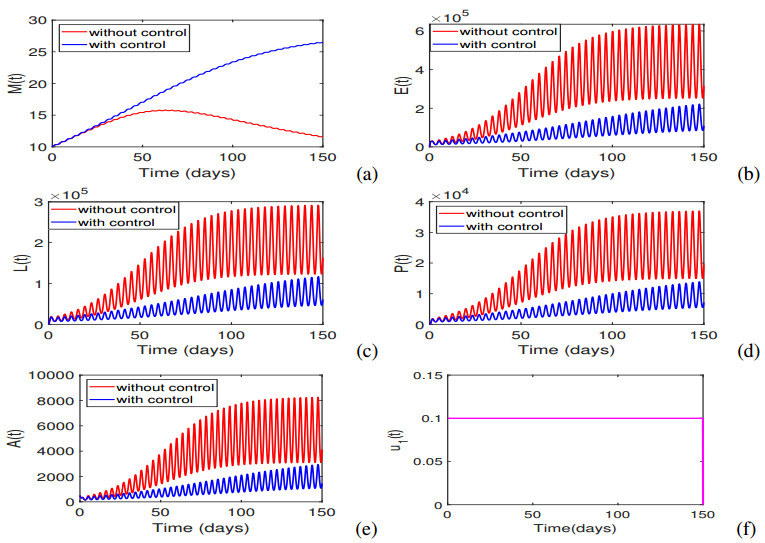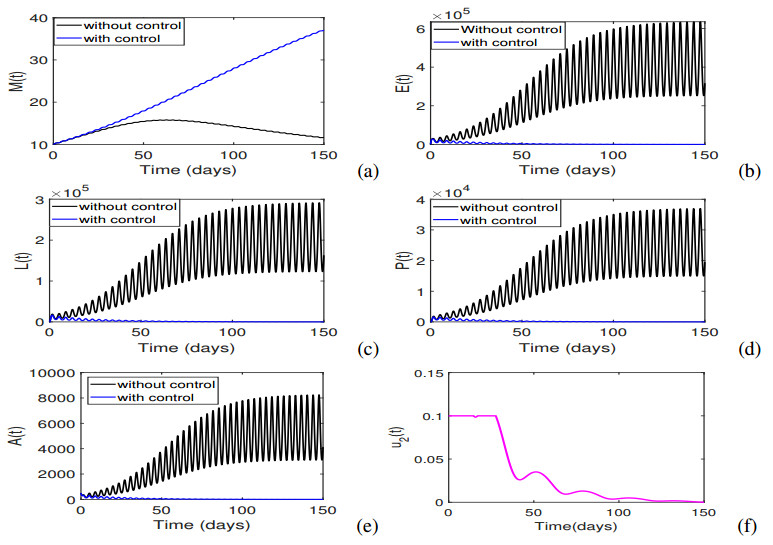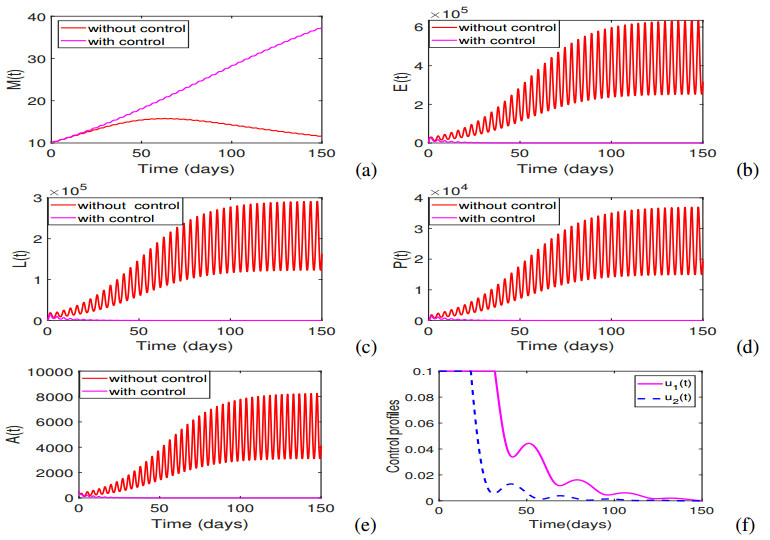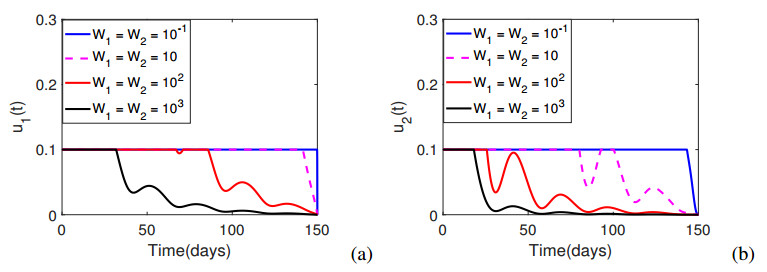1.
Introduction
Maize (Zea mays) is one of the most important cereals globally and is also referred as the "Queen of Cereals" due to its high yield potential [1]. Demand for maize is increasing, not only because of its higher nutritional benefits but also its ability to feed the growing global population and contribution to food security [2]. According to food and agriculture organization (FAO) [3], food security is a "situation that exists when all people, at all times, have physical, social, and economic access to sufficient, safe, and nutritious food that meets their dietary needs and food preferences for an active and healthy life".
In many African countries, agriculture remains an important contributor to food security, despite its inability to provide sufficient output to meet the needs of most of their populations. One of the main threats to food security in these countries is the recent invasion by fall armyworm, (FAW-Spodoptera frugiperda), a major pest of maize [2,3], native to tropical and subtropical parts of America [2,3,4], where it has more than 350 different crop and non-crop host plants [4]. The FAW was first reported in West and Central parts of Africa in 2016 but it rapidly spread to other parts of the continent with high devastating effect on maize production [2,5,6].
According to Goergen et al [8], the infestation of African countries with the FAW has huge consequences for their economies, agricultural yield and access to overseas markets [8]. It is estimated that about $US13 billion per annum in crop losses throughout sub-Saharan Africa are due to FAW infestation, thus, threatening the livelihoods with a majority of poor farmers [7,9]. For instance, a recent research on the impact of FAW on maize biomass in Ghana and Zambia revealed that the national mean loss of maize crops was 45% (range 22–67%) and 40% (range 25–50%) respectively [2].
Like any other insect pests, weather conditions in a season have an effect on maize biomass and FAW dynamics. Prior studies on pest biology have shown that the distribution and abundance of pests is largely influenced by relationship between their developmental rates and temperature [10,11]. In particular, different development stages of insects are favored by different temperature ranges, hence, temperature variations influence the development rates, duration of life cycles, and, ultimately, the survival of insects [11]. Furthermore, an increase in the ambient temperature to the near thermal optimum for insects causes increase in their metabolism, and, consequently, their activities [11]. Since temperature fluctuates in the natural environment, it follows that the development rates of insects vary seasonally. For FAW in particular, prior studies suggest that, populations in a given area directly depend on the time in a season, host plants availability, and weather conditions [5]. Under unfavourable weather condition and scarcity of food for the development and reproduction, FAW is forced to migrate to other suitable locations for survival [5,12].
As the evidence for climate impacts on FAW has increased, it is imperative that the mathematical models designed to explore the relationship between FAW and maize crops accommodate the effects of seasonal variations. The main goal of this study is to develop and analyze a non-autonomous FAW-maize interaction model. Despite a considerable number of studies on plant-pest interactions (see, for example, [15,16,17,18,19,20,21,22,23]), there are few studies that have been devoted to explore FAW and maize interaction.
One of the notable recent mathematical models for FAW and maize interaction was proposed by Faithpraise and coworkers [16] who evaluated the effects of biocontrol on managing FAW infestations in cereal crops among several other outcomes. The findings from their study revealed that, biocontrol could significantly control FAW infestations in cereal crops. Although this study improved the existing knowledge on FAW, one of its limitations was that development rates for the pest were all assumed to be constant yet in reality these depends on time. Thus, the present study is motivated by this existing research gap. Our results are new and, to our knowledge, very little work has been done so far on modelling and analysing the effects of seasonal variation in a FAW-maize interaction model with a saturation functional response.
2.
Basic non-autonomous model
2.1. Model derivations
Biologically, maize seed planted at the beginning of the season at time t=0 germinates in 0−7 days [13]. Depending on the variety of maize seed planted, harvest of this crop which occurs at the end of the season (90–164) days is influenced by the weather variations within a season. Since maize growth is affected by weather condition fluctuation, the growth rates of their parts such as leaves, cobs, kernel, and stems which in fact called biomass according to Chowdhury and Battude [14,22] are weather dependent [13]. Motivated by recent mathematical models for plant-pest interactions (see., for example [15,16,17,18,19,20,21,22,23], in this study we develop a non-autonomous model for FAW infestations in a field of maize biomass under assumption that (i) once the FAW moths migrate into the field, no migration out of the field occurs before the harvest (ii) weather condition fluctuation in a season have an impact on maize biomass and FAW dynamics. The developed model subdivides the FAW population of life cycle into subclasses as: eggs population E(t), larvae population L(t), pupae population P(t) and adult population which are also known as moth A(t). On the other hand, we let the variable M(t) denote the population density of maize biomass which grow logistically in the absence of the larvae with carrying capacity KM and a net seasonal growth rate r(t). We assume that larvae with a mortality rate μL(t) is the only threat to maize biomass throughout its growth period and the adult moth takes over in the reproduction process. The life cycle of FAW starts when eggs are laid in masses on maize biomass, mostly underside of these biomass [36]. We also assume that production of FAW egg is a logistic growth b(t)[1−E(t)KE(t)]wA(t) with b(t) representing the average number of eggs laid by a proportion w of moth, A(t) which are females. Since the growth of maize plants depends on seasonal variations, it suffices to assume that the egg carrying capacity KE(t), egg hatching rate αE(t) and egg mortality rate μE(t) are season-dependent. Furthermore, FAW larvae generally emerge simultaneously three to five days following oviposition. Although, the FAW has six larval instar stages, we have considered this as single group called larvae in order to reduce complexity of the model. Since the population size of maize biomass is finite and independent of weather fluctuation and because the rate at which FAW larvae consumes food decreases, a Holling type II functional response also known as the saturating functional response is included in the equation capturing the dynamics of maize density and larvae population with half saturation constant a(t). In particular, when FAW larvae feed on maize biomass, the FAW larvae with an average duration of 1αL(t) in the larval stage convert maize biomass into larvae's biomass at the rate e(t). Finally, pupation of the FAW normally occurs in the soil, at a depth of 2–8 cm [33]. We assume that, duration of the pupal stage with natural mortality rate μP(t) is denoted by 1αP(t) which after 8 days in the soil escapes as adult moth and start the cycle again. The model explanations above can be represented schematically in Figure 1:
The proposed model is summarized by the following system of nonlinear ordinary differential Equations in (1)
where μA(t) represents natural mortality rate of the moth (adult moth) and θ(t) is the density-dependent death rate of larvae population. Thus, −θ(t)L2(t) reflects of predation, intra-specific and interspecific competition that is known to exist on FAW larave population. Precisely, prior studies suggest that when food is limited, the older FAW larvae exhibit a cannibalistic behavior on the smaller larvae [24,25].
All model parameters that are functions of time depend on seasonal variations. For biological significance, we assume that all these parameters are continuous and bounded functions defined on R+. We now provide a comprehensive definition to model parameters that are meant to capture seasonal fluctuations, that is;
where ω>0 represent the period. Further, r0,β0,KE0,a0,b0,αE0,μE0,e0, αL0,μL0,θ0, αP0 and μA0 are the baseline values or the time averages of r(t),KE(t), b(t),αE(t),μE(t),e(t),β(t),αL(t),μL(t),θ(t),αP(t), μA(t),a(t), respectively, and r1,KM1,β1,KE1,a1,b1,αE1,μE1,e1,αL1, μL1,θ1,αP1 and μA1 denote the magnitude of seasonal fluctuations. Note that 0<r1<1, 0<β1<1,0<KE1<1,0<a1<1,0<b1<1,0<αE1<1,0<μE1<1,0<e1<1,0<αL1<1,0<μL1<1,0<θ1<1,0<αP1<1 and 0<μA1<1. From Eq (2) we can observe that all model parameters that account for seasonal fluctuations are periodic (with period ω>0 days), continuous and bounded below and above. Since |cos(2πtω−1)|≤1 and 0<r1<1, it follows that:
Therefore, we conclude that r(t) is bounded below and above. By following the same approach one can easily verify that all the other periodic model parameters are bounded below and above. Next, we investigate the dynamics of system (1), in particular we will focus on the positive invariance, nonpersistence, permanence, global attractivity of the bounded positive solutions and the boundary solution.
2.2. Positivity, boundedness and permanence of model solutions
In this subsection, we will prove for positivity, boundedness, global asymptotic stability of the bounded positive solution and permanence of system (1).
Definition 1. The set of solution for the system (1) is said to be ultimately bounded if ∃M>0, such that for each solution (M(t),E(t),L(t),P(t),A(t)) of (1), there ∃T>0, such that ‖(M(t),E(t),L(t),P(t),A(t))‖≤M∀t>T, with M independent of a particular solution and T may depend on the solution.
Definition 2. Model system (1) is said to be permanent if there exists δ+ and Δ+ with 0<δ+<Δ+ such that:
for all solutions of (1) with initial values being positive hold. Model system (1) is said to be non-persistent if there exists a positive solution (M(t),E(t),L(t),P(t),A(t)) of system (1) satisfying:
Given u∈C(R), we define Φ(u(s))=u(s)a(s)+u(s) and observe that, Φ(u) is a monotonic increasing function. Defining;
Then, we define condition (H1) using Eq (4) as follows:
Using condition (H1) in Eq (5), we define the set:
Based on definitions 1 and 2, we have Theorem 1 and its proof is in Appendix A.
Theorem 1.
(i) The solution set Ω of the system (1) is said to be positively invariant if condition (H1) holds and it is permanent if the solution set Ωδ of the system (1) defined by:
is ultimately a bounded region of (1), where δ>0 sufficiently small so that mδi>0(i=1,...,5) and condition (H1) holds when Mi and mi are replaced by Mδi and mδi, respectively. Further, we define Mδi=Mi+δ, mδi=mi−δ.
(ii) System (1) has at-least one ω− periodic solution (M∗(t),E∗(t),L∗(t),P∗(t),A∗(t))∈Ω if condition (H1) holds.
Biological implications of Theorem 1: Theorem 1 implies that model system (1) is biologically well-poised, that is., the population of species under consideration are non-negative and bounded.
3.
Dynamical behaviors of the non-autonomous model with optimal control
3.1. Model formulation
In this section, we extend the basic system (1) to incorporate time dependent intervention strategies with the main goal of reducing FAW egg and larvae populations. Considering the extent of damage FAW can cause in a short period of time, it is imperative that once this pest has been identified in a maize field, necessary control approaches should be implemented timeously. Prior studies suggest that the effective management of FAW depends on the integration of several control strategies which include biological control, host-plant resistance, and use of chemical insecticides [6]. Here, we reformulate system (1) to incorporate new parameter u1(t) and u2(t). Control u1(t) models the efforts of traditional control methods like handpicking and destruction of FAW egg masses and larvae on FAW dynamics. Control u2(t) accounts for the efforts of chemical pesticide use on FAW dynamics. Without loss in generality, herein we will use the term traditional methods to denote handpicking and destruction of FAW egg masses and larvae. Utilizing similar variable and parameter names as in Eq (1), the new system of nonlinear differential equations incorporating time dependent controls is given by:
As we can observe, control efforts u1(t) aims to reduce the egg and larvae population while the use of chemical insecticide u2(t) mainly reduces the density of larvae population only. For Eq (6) to be biologically meaningful we set:
The control set for the controls is defined as:
where u1max and u2max represents the upper bounds for the efforts of traditional methods and use of chemical insecticide respectively. If ui=0, (i=1,2), it implies absence of time dependent control measures.
A control strategy is said to be successful control strategy if it can reduce the egg and larvae population thereby reducing or eradicating FAW population in the field. As such, our aim here is to identify a pair of characterized control strategy (u∗1,u∗2) that reduces the population of FAW egg and larvae at minimal cost. To obtain a pair of characterized control strategy (u∗1,u∗2), we propose an objective functional with quadratic in control which according to Lahrouz and Gaff [34,35], (i) controls will not disappear after differentiation and this implies that the solution is unique (ii) all control strategies (u∗1,u∗2) are bounded implying that efforts for implementing these controls are also bounded and characterized. Thus, the following objective functional is proposed:
subject to the constraints (6) and where C1, C2, W1 and W2 are balancing coefficients (non-negative) converting the integrals into monetary quantity over a finite period of time, T days.
The optimal control problem, thus, becomes that, we seek optimal functions, (u∗1(t),u∗2(t)), so that:
subject to the state equations in system (6) with initial conditions. In order to study the existence of an optimal control pair (u∗1,u∗2), we will make use of Fleming and Rishel's work [30]. Theorem 2 (i) and (ii) state the existence of the optimal controls and their characterization.
Theorem 2.
(i) There ∃ an optimal control pair (u∗1,u∗2) to the problem (6).
(ii) Given an optimal control u=(u1,u2)∈U and corresponding state solutions M,E, L, A and P, there exists adjoint functions λi, i=1,...,5 satisfying:
with transversality condition λi(T)=0, for i=1,...,5. Moreover, these optimal controls are characterized by:
Theorem 2(i) There exists an optimal control pair (u∗1,u∗2) to the problem (6).
Proof. Suppose that f(t,x,u) be the right hand side of the (6) whereby x=(M,E,L,P,A) and u=(u1(t),u2(t)) represent the vector of state variables and control functions respectively. We list the requirements for the existence of optimal control as presented in Fleming and Rishel (1975) [30]:
1)The function f is of class C1 and there exists a constant C such that |f(t,0,0)|≤C,|fx(t,x,u)|≤C(1+|u|),|fu(t,x,u)|≤C;
2)the admissible set of all solutions to system (6) with corresponding control in Ω is non empty;
3)f(t,x,u)=a(t,x)+b(t,x)u;
4)the control set U=[0,u1max]×[0,u2max] is compact, closed, and convex;
5)the integrand of the objective functional is convex in U.
To verify these conditions, we write:
From Eq (12), it is evident that f(t,x,u) is of class C1 and |f(t,0,0)|=0. Furthermore, one can easily compute |fx(t,x,u)| and |fu(t,x,u)|, and demonstrate that:
Due to the condition 1, the existence of the unique solution for condition 2 for bounded control is satisfied. On the other hand, the quantity f(t,x,u) is expressed as a linear function of the control variables which satisfy the condition 3.
Theorem 2(ii) Given an optimal control u=(u1,u2)∈U and corresponding state solutions M,E, L, P and P, there exists adjoint functions λi, i=1,2,3,4,5 satisfying Eqs (10) and (11).
Proof. To characterize our optimal control problem we use Pontryagin's Maximum Principle [31], to formulate the following Hamiltonian function:
Next we determine the adjoint equations as follows; ∂λidt=−∂H∂x, where x=(M(t),E(t),L(t),P(t),A(t)), with transversality condition λi(T)=0 for i=1,2,3,4,5, and obtained the results in equation (10). Now, we minimize the Hamiltonian with respect to the controls. Note that we have required the convexity for minimization, ∂2H∂u2i=Wi>0,i=1,2. On the interior of the control set, we have:
Using the standard arguments and the bounds for the controls, one gets the characterization of this optimal pair (11).
3.2. Numerical results
In this section, we support analytical results of this study by simulating model (6) by making use of the following assumed initial conditions:E(0)=500, L(0)=0, P(0)=0, A(0)=500, and M(0)=10, as well as parameter values in Table 1.
Without loss of generality, we will fix all parameters that model the amplitude of seasonal dependent parameters (r1,KM1,β1,KE1,a1,b1,αE1,μE1,e1,αL1,μL1,θ1,αP1 and μA1) to 0.8. Furthermore, we set ω=7, that is., a small period was considered since the life span of FAW and maize in the field is very short.
It is worth noting that numerical simulations presented here were obtained by solving system (6) using the forward-backward sweep method [37] and the parameter values in Table 1. In addition, we considered the following assumed initial conditions; E(0)=500, L(0)=0, P(0)=0, A(0)=500, and M(0)=10. The initial step of the forward-backward sweep method is to assign an initial guess for the controls and then solve the system forward in time, followed by solving the adjoint state backward in time. Then these optimal controls are updated for optimality using the Hamiltonian of the optimal system. "The controls are then updated by using a convex combination of the previous controls and the value from the characterizations of the controls. This process is repeated and iterations are ceased if the values of the unknowns at the previous iterations are very close to the ones at the present iterations" [37]. For a detailed discussion we refer the reader to [37]. The numerical results presented in this Section are based on the following scenarios:
(i) Effects of implementing traditional control measures alone,
(ii) Effects of implementing time-dependent use of chemical insecticides alone, and
(iii) Effects of combining time-dependent traditional methods with use of chemical insecticides.
In addition, since the impact of larvae on maize is so apparent, we will assume that C1≤C2, that is, the minimization of caterpillars is more important than that of FAW eggs. Furthermore, traditional methods of controlling FAW are known to be less costly compared to chemical insecticides and as such, we will assume that W1<W2.
3.2.1. Effects of implementing traditional control measures alone
In resource limited settings, majority of the farmers cannot purchase pesticides to control FAW whenever there is an outbreak and more often they rely on traditional methods like handpicking and destroying of egg masses and larvae. Here, we seek to understand the effects of time dependent implementation of such methods on the dynamics of FAW and maize interaction. To investigate this scenario, we simulated model (6) with u1≠0 (0≤u1≤0.1) and u2≠0 and we obtained the results illustrated in Figure 2. As we can observe, the dynamics of the maize biomass and FAW populations, with and without control, will be associated with oscillations which reflect seasonal variations. Further, we can also observe that without control, the maize biomass may not exceed 15 kg per plant, however, with timely control, the biomass may exceed 25 kg per plant by the final time horizon (t=150). Moreover, although traditional methods will be capable of reducing FAW population and increasing maize biomass, they will not be able to completely eliminate the pest. Figure 2(f) portrays the optimal control profiles for u1(t). We clearly observe that u1(t) starts from the maximum (u1=0.1) and stays at that level for the entire duration. From the pattern of the optimal control profile we can conclude that a desirable outcome can be achieved only if the traditional methods are implemented throughout the entire time horizon.
3.2.2. Effects of implementing time-dependent use of chemical insecticides alone
Despite being expensive, chemical insecticides are known to be more efficient compared to traditional methods on controlling FAW. To explore the impact of chemical control measures on FAW dynamics we simulated model (6) with u1=0 and 0<u2(t)<0.1 and the results are depicted in Figure 3. When chemical insecticides are used, we can note that the population of FAW may become extinct in a period of 50 days. Moreover, the maize biomass per plant may exceed 35 kg per plant by the final time (t=150 days). Comparing the results portrayed in Figures 2 and 3, we conclude that the use of chemical insecticides should be encouraged since the final biomass will be higher compared to when farmers rely on traditional methods only. The control profile for control u2(t) starts from the maximum initially, but only for a very short time (t<50), followed by a decrease to some lower level till the final time horizon. This may attribute to the decrease in FAW populations. Hence, we conclude that for chemical insecticides, intensity use needs to be maintained at maximum for a period of approximately 50 days, thereafter the intensity may be reduced till the final time.
3.2.3. Effects of combining time dependent traditional methods with use of chemical insecticides
To understand the impact of combining traditional methods with use of chemical insecticides, we simulated model (6) with 0<u1(t)≤0.1 and 0<u2(t)≤0.1 over period of 150 days and the solution results are depicted in Figure 4. We can note that when traditional methods are combined with chemical insecticides use then the time taken to eliminate the FAW from the field is less than the time that will be taken if chemical insecticides were in use (Figure 4). Although the time required to eliminate the FAW populations will decrease, the final maize biomass may not be significantly different from that obtained when only chemical insecticides were in use (Figure 3). In Figure 4(f), we can observe that the control profiles for u1(t) and u2(t) starts at their respective maximum initially, but only for a very short time, followed by a decrease to some lower level till the final time. It is worth noting that the control profile for u1(t) remain at its maximum for a slightly longer period compared to that of u2(t) and this can be attributed to less cost associated with traditional methods relative to chemical insecticides use. As such we can conclude that when traditional methods are combined with chemical insecticides use, chemical control efforts may be ceased after approximately 50 days and the traditional methods can be implemented for additional 50 days or more but at low intensity. To assess the effects of costs on implementing the control efforts u1(t) and u2(t), we varied the weight constants W1 and W2 and the results are illustrated in Figure 5. From the results we can note that if the costs are low, for example, W1=W2=0.1 then the associated control profile starts at their respective maximum and stays there till the final time horizon. However, as the cost increases the respective control profile starts at their respective maxima and stays there for a reduced duration compared to when the costs are low. In particular, as the cost increases the control profile for u2(t) stays at its maxima for a relatively short duration compared to that of u1(t). In a nutshell, we can deduce that depending on the cost parameters associated with the control, the optimal profiles of u1(t) and u2(t) stay at their respective maxima for a longer duration, before eventually settling at their minimum levels.
4.
Conclusions
We have formulated a mathematical model to investigate the effects of seasonal variations on the dynamics of maize biomass and FAW interaction. After a comprehensive analysis of the dynamical behavior of the proposed framework, we extended it to incorporate time-dependent control strategies, namely traditional methods (like handpicking and destruction of egg masses and larvae) and the use of chemical insecticides. Our optimal control is aimed at minimizing the numbers of the eggs and larvae population at minimal costs. Our results show that, in all the scenarios, the optimal control can greatly reduce the FAW population and in some instances, complete elimination of the pest may be attained. Future research could expand our analysis to include climate-sensitive aspects of FAW such as temperature and predict changes in population dynamics at various temperature ranges.
Acknowledgments
Salamida Daudi acknowledges the support received from the National Institute of Transport (NIT), Tanzania for giving me study leave and other requirements for PhD study at NM-AIST. Other authors are also grateful to their respective institutions for the support.
Conflict of interest
The authors declare that they have no competing interests.
Appendix
A. Proof of Theorem 1 and the discussion on global asymptotic stability of the boundary solution
In this section, we will provide the proof of Theorem 1 and we will discuss the global asymptotic stability of the boundary solutions of the model. We will begin our discussion by considering Theorem 1 (i):
To prove Theorem 1 (i), we will make use of the lemma as given by Bai et al [26], which was used to demonstrate the permanence of a non-autonomous prey-predator model with a generalist predator.
Lemma 1. Suppose p(t) and q(t) are bounded and continuous functions in R with inft∈Rp(t)>0 and inft∈Rq(t)>0. If there exist a positive function u(t) which satisfies:
then lim supt→+∞u(t)≤supt∈Rp(t)q(t). Moreover, u(t)≤supt∈Rp(t)q(t) for all t∈[t0,+∞) if 0<u(t0)≤supt∈Rp(t)q(t). On the other hand, if u(t) satisfies:
then lim inft→+∞u(t)≥inft∈Rp(t)q(t). Moreover, u(t)≥inft∈Rp(t)q(t) for all t∈[t0,+∞) if 0<u(t0)≥inft∈Rp(t)q(t).
We now demonstrate the proof for Theorem 1 as follows; Considering system (1), we have the following expressions:
From Eq (13), we can observe that all the solutions of model (1) are non-negative. We now demonstrate that, the solution set Ω of the system (1) is positively invariant. Let (M(t),E(t),L(t),P(t),A(t)) be a unique solution of system (1) with (M(t0),E(t0),L(t0),P(t0),A(t0))∈Ω. From the first equation of (1) and the positivity solutions of (1), we have:
and by Lemma 1 and 0<M(t0)≤M1, M(t)≤M1, t≥t0. Considering the second equation of the system (1), we have:
by Lemma 1 and 0<E(t0)≤M2, E(t)≤M2, t≥t0. From the third equation of model (1), we have:
by Lemma 1 and 0<L(t0)≤M3, L(t)≤M3, t≥t0. From the fourth equation of system (1), we have:
by Lemma 1 and 0<P(t0)≤M4, P(t)≤M4, t≥t0. From the last equation of system (1), we have:
Again from the first equation of system (1), we have:
and by Lemma 1 and M(t0)≥m1>0, we get M(t)≥m1, t≥t0. From the second equation of system (1), we have:
By Lemma 1 and E(t0)≥m2>0, it follows that E(t)≥m2, holds for t≥t0. From the third equation of system (1), we have:
It follows from Lemma 1 and L(t0)≥m3>0 thatL(t)≥m3, holds for t≥t0. From the fourth equation of system (1), we have:
By Lemma 1 and P(t0)≥m4>0 we have thus P(t)≥m3, holds fo t≥t0. Furthermore, from the last equation of system (1), we have:
which implies that by Lemma 1 and A(t0)≥m5 that A(t)≥m5 holds ∀t≥t0. Hence, the solution set Ω of the system (1) is positive invariant.
Suppose if the condition (H1) holds, now we prove that the model system (1) is permanent. We let (M(t),E(t),L(t),P(t),A(t)) be a unique solution of system (1) with positive initial value (M(t0),E(t0),L(t0),P(t0),A(t0)). Choose δ>0 which is sufficiently small so that mδi(i=1,2,3,4,5), and each inequality of (H1) holds when Mi and mi are replaced by Mδi>0 and mδi>0, respectively. By Lemma 1, it follows that lim supt→+∞M(t)≤M1, which follows that there exists T0>t0 such that for t>T0, M(t)≤Mδ1. Then from the first equation of system (1), we have:
which yields by Lemma 1 that:
Hence, by the arbitrariness of δ, we obtain lim supt→+∞M(t)≤M1. Then, there exists T1>T0 such that for t>T1, M(t)≤Mδ1, and:
It follows from Lemma 1 and inft∈R{b(t)wMδ5−[b(t)wMδ5+αE(t)+μE(t)]E(t)}>0 that
Hence, by the arbitrariness of δ, we have lim supt→+∞E(t)≤M2, and there exists T2>T1 such that for t>T2, E(t)≤Mδ2, and
It follows from Lemma 1 and inft∈R{eβ(t)Φ(Mδ1)(t)L(t)−[αL(t)+μL(t)]}>0 that:
Hence, by the arbitrariness of δ, we have lim supt→+∞L(t)≤M3, and there exists T3>T2 such that for t>T3, L(t)≤Mδ3, and:
which yields by Lemma 1 that:
Hence, by the arbitrariness of δ, we obtain lim supt→+∞P(t)≤M4. Then, there exists T4>T3 such that for t>T4, P(t)≤Mδ4, and:
which yields by Lemma 1 that:
Hence, by the arbitrariness of δ, we obtain lim supt→+∞A(t)≤M5. Then, there exists T5>T4 such that for t>T4, A(t)≤Mδ5. This completes the proof of Theorem 1(i).
In what follows, we will investigate the global asymptotic stability of the boundary solution. We will assume that the maize biomass is the only food source for the FAW in this case; such that in the absence of the maize plant biomass, the FAW population becomes extinct. Hence the only boundary solution of system (1) is (M(t),0,0,0,0). Substituting this boundary solution into system (1) one gets:
Equation (14) is well known non-autonomous logistic equation. As illustrated in equation (3), r(t) is continuous ω−periodic, bounded below and above by positive constants. According to Fan and Wang [27], we have the following results:
Lemma 2. (Reference [27]): If r(t) is a continuous ω− periodic function, and bounded below and above by strictly positive reals for all t∈R, the logistic Eq (14) has exactly a solution Mg(t) bounded below and above by positive constants. Precisely, this solution is given by:
In addition, Mg(t) is globally asymptotically stable for M(t) with positive initial value M(t0)=M0>0 in the sense limt→+∞|M(t)−Mg(t)|=0.
By Lemma 2, we obtain the following result:
Lemma 3. System (1) admits a unique positive ω−periodic solution Mg(t),0,0,0,0) which is globally asymptotically stable for M(t) with positive initial value M(t0)=M0>0 in the sense limt→+∞|M(t)−Mg(t)|=0.
For a continuous and periodic function g(t) with periodic ω, we denote:
Lemma 4. (Reference [28]): If r(t) is a continuous ω−periodic function, then the null solution of (14) is globally asymptotically stable provided that one of the following two conditions is met:
(1) A(r)<0;
(2) A(r)=0, and A(r/KM)<0.
Note: If A(r)>0 and A(r/KM)>0, then (14) has a unique positive ω−periodic solution Mg(t) which is globally asymptotically stable (see Tineo [29]). Thus, when r/KM is non-negative with A(r/KM)>0, the null solution of (14) is globally stable if and only if A(r)≤0.
Finally, we we provide the proof of Theorem 1(ii):
Define a Poincare mapping F:R5→R5 as follows:
where (M(t0+ω,t0,ξ),E(t0+ω,t0,ξ),L(t0+ω,t0,ξ),P(t0+ω,t0,ξ),A(t0+ω,t0,ξ)) represents the solution of (1) through (t0,ξ), ξ=(M0,E0,L0,P0,A0)∈R5. By the positive invariant property of Ω,F(Ω)∩Ω. The continuity of F can be guaranteed by the continuity of solution of Eq (1) with respect to initial value. Note that Ω is closed, bounded, convex set in R5. Therefore, it follows from Brouwer's theorem of fixed point that the operator F has at least one fixed point ξ∗=(M∗(t),E∗(t),L∗(t),P∗(t),A∗(t)) in Ω, which is a positive ω− periodic solution of system (1). The proof is complete.
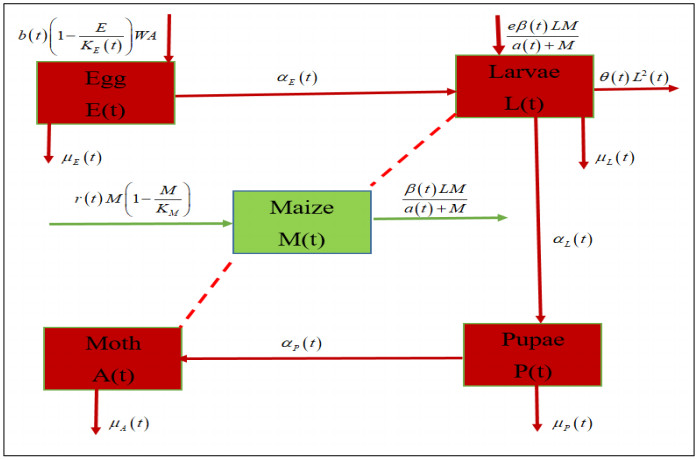









 DownLoad:
DownLoad:
